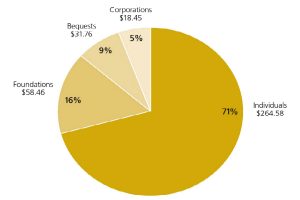Kathleen Kane, executive vice president of development at City of Hope in Duarte, Calif., said she’s seen donors who want to give to the organization but are too shaken by the recent economic collapse to make a commitment.
“We had a gentleman in here who was about to sign something irrevocably, a man in his mid-80s with his family there and really wanted to do it. At the last moment he said, ‘I can’t do this. I’ll make it revocable in my will but I just can’t sign on the dotted line today,’” said Kane. “And I think there is a lot of that fear.”
Kane explained that most donors are too spooked about the economy to even think about multi-year commitments, especially when donors are looking at significant decreases in their stock portfolios and real estate values. “They will maybe give you a gift this year from their income but they are not willing to look at their asset base and pledge that out during a period of time,” she said.
One way to approach the shy donor base is to start talking about planned giving, according to Daphne Halpern, vice president of development at Monmouth Medical Center Foundation in Long Branch, N.J. Halpern said that donors are holding their money tightly while they are uncertain about the not-so-distant future.
“They are waiting to see what will happen next with their asset base,” she said. “Even people who are tremendously wealthy who you would think would be primary donors, they still have a lessening of their assets and they are holding on to them just like someone who has much less disposable wealth.”
As the population ages, “it’s just a helpful conversation to have. And it turns new donors into great friends,” said Halpern. “I think this is the time to bring the strategy back.”
According to Lisa Hillman, senior vice president and chief development officer at Anne Arundel Health System and executive director of the Anne Arundel Medical Center Foundation in Annapolis, Md., “There are a lot of us that felt that last year we either met our goals or came close.”
There is a delayed reaction to give, she said. “As more and more people lose their jobs, as corporations downsize and as people continue to worry over what their futures are, this coming year could end up being equally if not more challenging,” said Hillman, who also serves as board chair for the Association for Healthcare Philanthropy.
Hillman said Anne Arundel hired a full-time planned giving officer during the past year because the economy has prompted people to take stock of their assets and restructure their finances, which is a good time for hospitals to discuss planned giving.
Tony Martignetti, managing director of Martignetti Planned Giving Advisors in New York City, said he’s seen an increased interest in planned giving since other fundraising channels are decreasing. “Obviously, the older Americans are using healthcare at a higher rate than younger Americans. And, there is enormous gratitude,” said Martignetti. “The older we get, the more serious the interventions become and the more grateful the patients are.”
He explained that while planned giving isn’t going to replace your $50 to $100 yearly donors, development professionals should be discussing estate planning with $10,000 to $50,000 range donors. He explained that healthcare development staff should first make the argument why donors should give.
“[Potential donors] see huge buildings, hundreds or thousands of beds and think there is tremendous wealth in the institution,” said Martignetti. “What that means for hospitals is that they will have to work harder at explaining their nonprofit mission and explaining what the needs are.”
Martignetti also suggested looking at a variety of planned giving options. With charitable trust alternatives, organizations can receive payments before the donor dies. Development departments should also talk about charitable gift annuities that pay a fixed income for the donor’s life. He explained that donors might appreciate the stability of the supplement retirement income from the annuities with rates higher than commercial savings accounts or certificates of deposit, and the donor receives a charitable deduction when making the gift without waiting for the deduction for estate.
Martignetti said the complexity of an organization’s planned giving program usually relates to the size, but smaller organizations should still look into programs, such as bequests.
“Bequests are always the place to start,” he said. “Regardless of what kind of charity it is, bequests are always the most popular planned gift.”
***
This article is from NPT Weekly, a publication of The NonProfit Times.
Subscribe to The NPT Weekly eNewsletter or any of our other enewsletters and get the latest news and ideas related to fundraising delivered to your inbox










